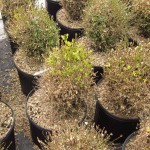Boxwood Blight: How to Recognize It and What to Do About It
Our beautiful boxwoods are under attack by a new disease. First seen in England in the 1990’s, the blight was found in North Carolina and Connecticut in late 2011. By last year it had shown up in ten states, including Massachusetts. Boxwood blight is new fungal disease which is not cured by any current fungicides.
All boxwood, including the popular ‘English’ and ‘American’ varieties, are susceptible to the disease. Other members of the boxwood family, Pachysandra terminalis (Allegheny spurge) and Pachysandra procumbens ( ‘Japanese’ pachysandra) as well as member so the Saracoccca species are also attacked by this pathogen.
What does it look like? The blight begins with dark or light brown spots or lesions on the leaves. The leaves turn brown, fall off while the stems develop brown or black lesions. The leaves are lost very quickly after the first signs of the disease appear. The roots are not attacked and the plant may try to put out fresh leaves. Repeated defoliations will kill the plants that don’t die immediately.
How does it spread? The fungal spores are spread by both wind and water (rain or sprinklers). Because they are sticky, they are probably also spread by animals including birds and contaminated clothing and tools. Disease spore on infected leaves that have fallen to the ground can survive five years.
But researchers believe that currently the most common method of transmission is when supposedly ‘clean’ plants are brought into an area of established boxwood. The carriers may be asymptomatic because they were treated with fungicides that have masked, but not killed the disease.
Warm and humid conditions create an environment where the fungus spreads quickly. Only high humidity or water on the leaves, not a wound on the plant, is required for the fungus to infect the plant.
There is no known cure. Fungicides intended to prevent the spread of the disease must be applied to both sides of every leaf and all of the stems. When you think of how closely spaced boxwood leaves are, you realize that this is probably not a practical method for the homeowner.

Attacked by blight, boxwoods lose their leaves. The blight may kill the plant outright. If the boxwood puts out new leaves, those, too, will die.
How do I protect my boxwood? Think carefully before buying any new boxwood until research finds a cure. If you do buy boxwood, buy only from reputable nurseries. Once the plant is home, isolate it for a month or longer.
Water your boxwood via drip irrigation, never with overhead sprinklers. Don’t prune, examine or otherwise work with wet boxwood. Clean your tools and replace your gloves before going from one plant to the next.
If you think you have an infected plant, remove it, bag it in plastic and place it away from any other boxwood. Send a sample to a lab for confirmation. There are several treatable diseases that share symptoms with the new boxwood blight.
If you are replanting an area where boxwood grew, consider another species outside the Buxus (boxwood) family.
Many researchers are working on finding a cure or a control for Boxwood Blight. Updates can be found on the Connecticut state website (www.ct/gov/caes/pdio) and the ALNA website (www.BoxwoodBlight.org).

